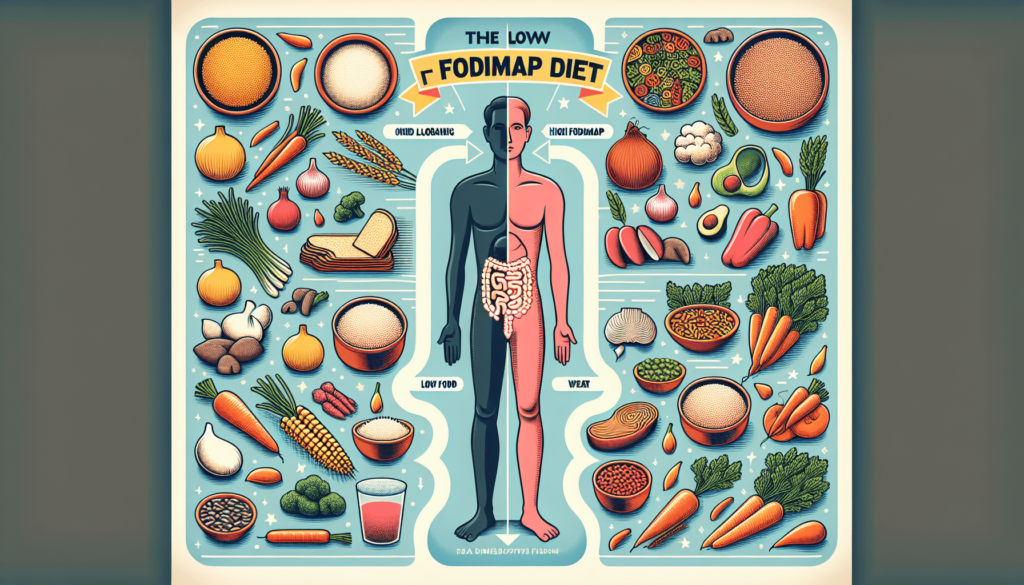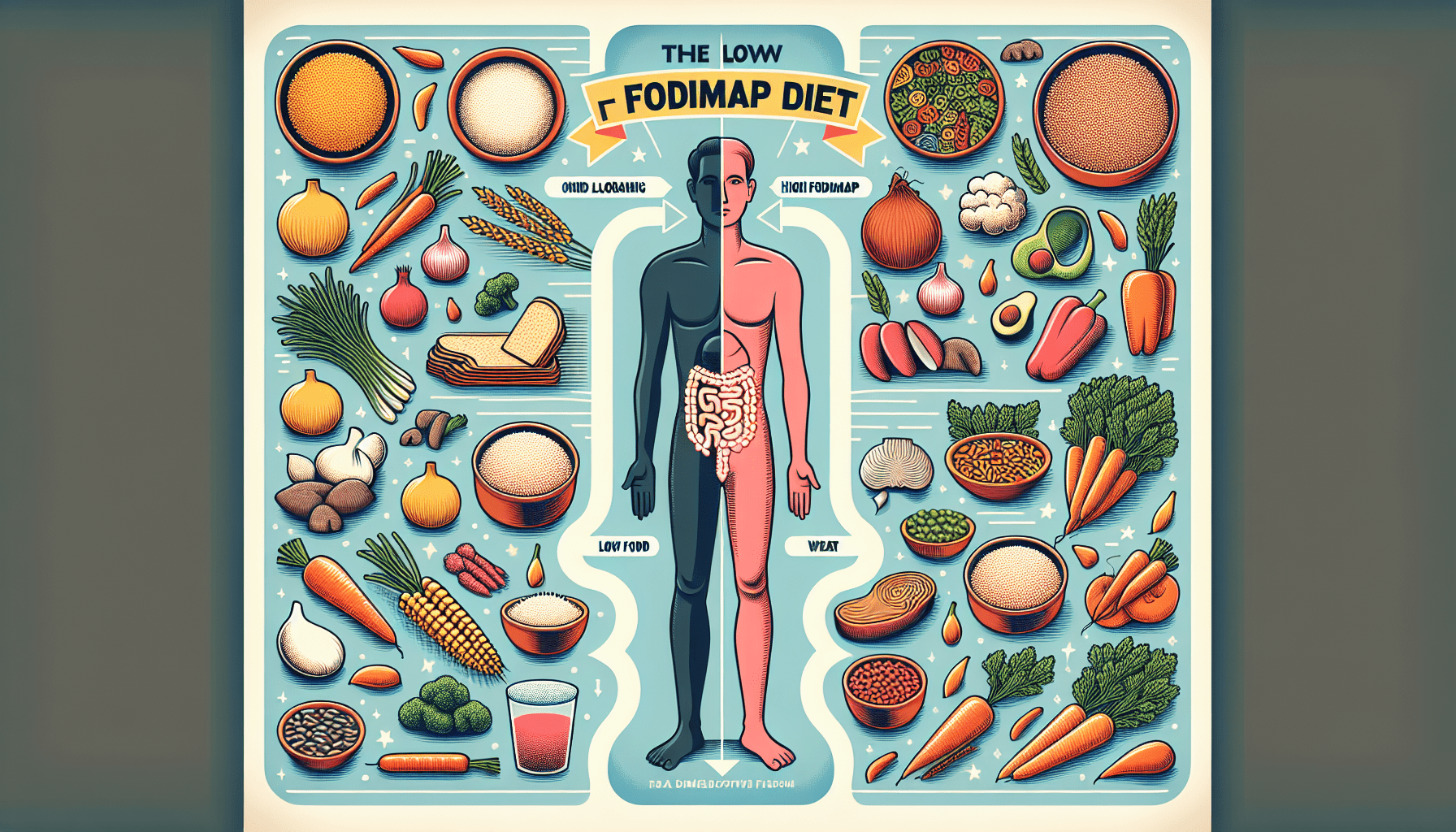Are you constantly struggling with uncomfortable digestive issues like bloating, gas, and stomach pain? If so, you may want to consider learning more about the Low FODMAP Diet. This revolutionary approach to managing digestive disorders focuses on eliminating certain fermentable carbohydrates from your diet temporarily, helping to alleviate symptoms. In this article, you’ll gain a better understanding of what the Low FODMAP Diet entails and how it can potentially bring relief to those suffering from irritable bowel syndrome (IBS) and other digestive disorders. So, let’s dive in and explore the world of the Low FODMAP Diet together!

What is a Low FODMAP Diet?
A Low FODMAP Diet is a dietary approach designed to help manage the symptoms of digestive disorders such as irritable bowel syndrome (IBS) and inflammatory bowel diseases (IBD). FODMAPs, which stands for Fermentable Oligosaccharides, Disaccharides, Monosaccharides, and Polyols, are a group of carbohydrates that can be difficult for some individuals to digest properly. These carbohydrates are found in a variety of foods and can contribute to digestive symptoms such as bloating, gas, abdominal pain, and diarrhea.
Definition of FODMAPs
FODMAPs are a type of carbohydrate that are classified as fermentable, meaning they are broken down by bacteria in the gut. The different types of FODMAPs include oligosaccharides, which are found in foods like wheat, rye, onions, and garlic; disaccharides, which are found in lactose-containing dairy products; monosaccharides, which are found in fruits and honey; and polyols, which are sugar alcohols found in artificial sweeteners and certain fruits and vegetables.
Role of FODMAPs in Digestive Disorders
For individuals with certain digestive disorders, such as IBS and IBD, the digestion and absorption of FODMAPs can be impaired. This can lead to an overgrowth of bacteria in the small intestine and an increase in gut fermentation, resulting in the production of gas and other byproducts. This can cause symptoms such as bloating, distension, pain, and changes in bowel habits.
The Purpose of a Low FODMAP Diet
The main purpose of a Low FODMAP Diet is to reduce the intake of FODMAPs in order to alleviate the symptoms of digestive disorders. By limiting the consumption of FODMAPs, individuals can decrease the amount of gas produced in the gut and reduce the fermentation processes that can lead to symptoms. The diet is typically implemented in three phases: elimination, reintroduction, and maintenance.
Identifying Foods High in FODMAPs
Common High FODMAP Foods
There are many common foods that are high in FODMAPs. These include certain fruits such as apples, pears, and watermelon; vegetables like onions, garlic, and mushrooms; dairy products that contain lactose such as milk, ice cream, and soft cheeses; grains like wheat and rye; and artificial sweeteners like sorbitol and xylitol. It is important to note that the FODMAP content of foods can vary depending on factors such as ripeness, cooking methods, and portion size.
Reading Food Labels for FODMAPs
When following a Low FODMAP Diet, it is essential to carefully read food labels in order to identify any potential sources of FODMAPs. Look for ingredients that may indicate the presence of FODMAPs, such as high fructose corn syrup, wheat, or lactose. Additionally, keep an eye out for hidden sources of FODMAPs, such as garlic or onion powder in spice mixes or sauces.
Hidden Sources of FODMAPs
In addition to obvious sources of FODMAPs, there are also hidden sources that may not be as easily recognized. Some examples include certain additives and preservatives, condiments, sauces, and processed foods. These can often contain high levels of FODMAPs, so it is important to be vigilant when selecting and consuming these types of foods.
Benefits of a Low FODMAP Diet
Reduced Digestive Symptoms
One of the main benefits of following a Low FODMAP Diet is a reduction in digestive symptoms such as bloating, gas, abdominal pain, and diarrhea. By eliminating or reducing the intake of high FODMAP foods, individuals can often experience a significant improvement in their symptoms.
Improved Quality of Life
Managing digestive symptoms can greatly improve an individual’s quality of life. By reducing or eliminating symptoms such as bloating and abdominal pain, individuals can experience increased comfort and overall well-being. This can lead to improvements in sleep, energy levels, and overall mood.
Potential Benefits for Other Conditions
While the Low FODMAP Diet is primarily used for managing digestive disorders, there is emerging evidence to suggest that it may also have potential benefits for other conditions. Some studies have shown that a Low FODMAP Diet may be beneficial for individuals with conditions such as fibromyalgia, endometriosis, and certain skin disorders. However, further research is needed in these areas to confirm these findings.
Getting Started with a Low FODMAP Diet
Consultation with a Registered Dietitian
Before starting a Low FODMAP Diet, it is recommended to consult with a registered dietitian who specializes in digestive health. They can provide guidance and support throughout the process, helping to ensure that the diet is followed correctly and tailored to individual needs.
Elimination Phase
The first phase of a Low FODMAP Diet is the elimination phase. During this phase, individuals eliminate all high FODMAP foods from their diet for a set period of time, usually around two to six weeks. This allows the gut to rest and symptoms to subside.
Reintroduction Phase
After the elimination phase, the reintroduction phase begins. This involves systematically reintroducing different groups of FODMAPs back into the diet to determine tolerance levels. This helps identify specific foods that may trigger symptoms and allows for a more personalized approach to the diet.
Maintenance Phase
The maintenance phase is the final part of the Low FODMAP Diet. Once tolerance levels have been established, individuals can reintroduce foods that are well-tolerated into their regular diet. However, it is important to continue monitoring symptoms and making adjustments as needed.
Tips for Following a Low FODMAP Diet
Meal Planning and Preparation
To successfully follow a Low FODMAP Diet, meal planning and preparation are key. This involves carefully selecting and preparing foods that are low in FODMAPs, as well as having a variety of options readily available. Planning meals and snacks in advance can help ensure that there are always suitable options on hand.
Substitute Ingredients and Recipe Modifications
Adapting recipes to make them Low FODMAP-friendly may require some creativity and substitutions. Fortunately, there are numerous ingredient alternatives available, such as gluten-free flours, lactose-free dairy products, and FODMAP-friendly sweeteners. Experimenting with different ingredients and recipe modifications can help individuals continue to enjoy a wide range of delicious meals while following the diet.
Maintaining a Balanced Diet
Although following a Low FODMAP Diet may involve restrictions, it is still important to maintain a balanced and nutritious eating plan. This includes consuming a variety of fruits, vegetables, whole grains, lean proteins, and healthy fats. It may be necessary to work with a dietitian to ensure that nutritional needs are being met while adhering to the diet.
Challenges and Limitations of a Low FODMAP Diet
Strictness of the Diet
The strictness of a Low FODMAP Diet can make it challenging for some individuals to follow. It requires careful attention to ingredient labels, meal planning, and constant monitoring of symptoms. Additionally, the elimination phase can be quite restrictive, which can be difficult for those who are accustomed to a diverse diet.
Potential Nutrient Deficiencies
Eliminating certain high FODMAP foods, particularly those that are rich in fiber and nutrients, can lead to potential nutrient deficiencies. It is important to replace these foods with suitable alternatives and consider appropriate supplementation if necessary. Working with a dietitian can help ensure that nutritional needs are being met throughout the diet.
Long-Term Sustainability
While the Low FODMAP Diet is effective in managing symptoms, it is not intended to be followed long-term. The elimination and reintroduction phases are temporary measures to identify trigger foods and establish tolerance levels. It is important to transition to a more sustainable and varied diet after completing the initial phases.
Potential Side Effects of a Low FODMAP Diet
Impact on Gut Microbiota
Following a Low FODMAP Diet may have an impact on the diversity and balance of the gut microbiota. Some studies have shown a decrease in beneficial bacteria during the elimination phase, although this appears to be reversible once high FODMAP foods are reintroduced. It is important to consult with a healthcare professional to monitor and support gut health during the diet.
Changes in Bowel Habits
As the diet involves changes in the types of carbohydrates consumed, individuals may experience changes in bowel habits such as constipation or diarrhea. This is often temporary and resolves once the diet is adjusted or completed. It is important to communicate any significant changes in bowel habits with a healthcare professional.
Risk of Disordered Eating Behaviors
Restrictive diets can potentially increase the risk of developing disordered eating behaviors. It is important to approach the Low FODMAP Diet with a healthy mindset and seek support from healthcare professionals if necessary. Ensuring a balanced and varied diet, as well as addressing any underlying psychological or emotional issues, is essential for long-term well-being.
Who Can Benefit from a Low FODMAP Diet?
Irritable Bowel Syndrome (IBS)
The Low FODMAP Diet has been shown to be effective in managing symptoms of IBS, a common digestive disorder characterized by abdominal pain, bloating, and changes in bowel habits. Individuals with IBS can often experience significant symptom relief by following the diet.
Inflammatory Bowel Diseases
While the Low FODMAP Diet is not a primary treatment for inflammatory bowel diseases such as Crohn’s disease and ulcerative colitis, it may be beneficial for managing symptoms during flare-ups. However, it is important to consult with a healthcare professional to determine if the diet is appropriate in individual cases.
Other Digestive Disorders
In addition to IBS and inflammatory bowel diseases, the Low FODMAP Diet may also benefit individuals with other digestive disorders such as small intestinal bacterial overgrowth (SIBO), functional dyspepsia, and celiac disease. Again, individualized guidance from a healthcare professional is essential in determining the suitability of the diet for these conditions.
Precautions and Considerations
Individualized Approach
It is important to recognize that each individual may have different trigger foods and tolerances when it comes to FODMAPs. Following a Low FODMAP Diet should be approached on an individual basis with the guidance of a healthcare professional or registered dietitian who can help tailor the diet to specific needs and address any potential concerns.
Monitoring and Support
Throughout the different phases of the Low FODMAP Diet, it is important to monitor symptoms and progress. Regular check-ins with a healthcare professional or registered dietitian can provide valuable support, guidance, and adjustments to ensure that the diet is effectively managed.
Reintroduction Phase Challenges
The reintroduction phase of the Low FODMAP Diet can be particularly challenging, as it requires systematic reintroduction of different FODMAP groups to identify individual tolerances. This phase may take time, patience, and careful monitoring. Working closely with a healthcare professional during this phase can be instrumental in successfully navigating the process.
Consulting a Healthcare Professional
Importance of Medical Guidance
Before embarking on a Low FODMAP Diet or making any significant dietary changes, it is crucial to consult with a healthcare professional. They can provide appropriate guidance, ensure that the diet is suitable for individual needs, and address any underlying health concerns.
Registered Dietitians
Registered Dietitians specializing in digestive health are valuable resources for individuals interested in following a Low FODMAP Diet. They have the expertise and knowledge to guide individuals through the different phases of the diet, offer personalized recommendations, and address any potential challenges or concerns.
Collaboration with Other Specialists
Depending on the individual’s specific situation and needs, collaboration with other healthcare specialists may be necessary. This can include gastroenterologists, psychologists, and other specialists who can provide additional support and expertise to address any underlying conditions or factors that may impact the success of the Low FODMAP Diet.
In conclusion, the Low FODMAP Diet is a valuable dietary approach for managing symptoms of digestive disorders such as IBS and IBD. By carefully selecting and limiting the intake of high FODMAP foods, individuals can experience a reduction in symptoms and improved quality of life. However, it is important to approach the diet with guidance from healthcare professionals and to be aware of potential challenges and limitations. The ultimate goal is to find a sustainable and individualized approach to managing digestive health and overall well-being.

